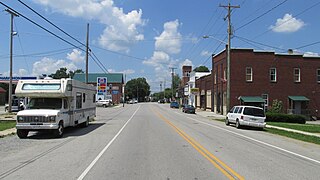
Millville is a village in Butler County, Ohio, United States. The population was 634 at the 2020 census. Millville sits between Oxford, Ohio and Cincinnati, Ohio along U.S. Route 27.

Gordon is a village in Darke County, Ohio, United States. The population was 245 at the 2020 census.

Ithaca is a village in Darke County, Ohio, United States. The population was 81 at the 2020 census.

Rossburg is a village in Darke County, Ohio, United States. The population was 159 at the 2020 census.

Jamestown is a village in Greene County, Ohio, United States. The population was 2,052 at the 2020 census.

Addyston is a village in Miami Township, Hamilton County, Ohio, United States. Located along the Ohio River, it is a western suburb of the neighboring city of Cincinnati. The population was 927 at the 2020 census.

Cleves is a village in Miami Township, Hamilton County, Ohio, United States. Located along the Ohio River, it is a western suburb of Cincinnati. The population was 3,414 at the 2020 census.

Mowrystown is a village in Highland County, Ohio, United States. The population was 385 at the 2020 census.

Hanover is a village in Licking County, Ohio, United States. The population was 1,270 at the 2020 census. The village lies along Ohio State Route 16.

Adelphi is a village in Ross County, Ohio, United States. The population was 322 at the 2020 census.

Clarksburg is a village in Ross County, Ohio, United States. The population was 409 at the 2020 census.

Frankfort is a village in Ross County, Ohio, United States, along the North Fork of Paint Creek. The village is located in Concord Township. The population was 1,084 at the 2020 census.

Kingston is a village in Ross County, Ohio, United States. The population was 1,262 at the 2020 census.

North Fork Village is an unincorporated community and former census-designated place (CDP) in Ross County, Ohio, United States. The population was 1,726 at the 2000 census. It was not delineated as a CDP for the 2010 census.

South Salem is a village in Ross County, Ohio, United States. The population was 219 at the 2020 census.

Port Jefferson is a village in Salem Township, Shelby County, Ohio, United States. The population was 308 at the 2020 census.

Limaville is a census-designated place (CDP) and former village in Stark County, Ohio, United States. The population was 151 at the 2020 census. It is part of the Canton–Massillon Metropolitan Statistical Area.

Wilson is a village in Belmont and Monroe counties in the U.S. state of Ohio. The population was 129 at the 2020 census. It is part of the Wheeling metropolitan area.

Gratiot is a village in Licking and Muskingum counties in the U.S. state of Ohio. The population was 215 at the 2020 census.
Bainbridge is a census-designated place (CDP) in Bainbridge Township, Geauga County, Ohio, United States. As of the 2020 census, the CDP had a population of 9,242.
book by Nancy Baum written in collaboration with the Bainbridge Historical Society























